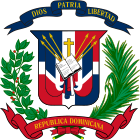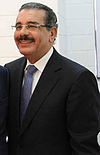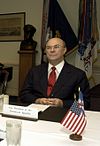2012 Dominican Republic presidential election
| ||||||||||||||||||||
| ||||||||||||||||||||
| ||||||||||||||||||||
 |
|---|
|
|
Presidential elections were held in the Dominican Republic on 20 May 2012.[1] They were the fifth quadrennial elections for the presidency and vice-presidency since 1998, when a change in the electoral law separated the presidential from the congressional and municipal elections.[2]
As specified in the new constitution ratified in January 2010, the presidential elections of 2012 coincided with the election of Overseas Deputies in Dominican expatriate communities.[3] Since 1974, elections in the Dominican Republic took place on 16 May every four years. Nevertheless, the constitutional reform of 2009 stipulated in article 209 that the elections would be held on 20 May 2012 to avoid their falling on a work day.[1] Candidates for the presidency competed for the highest number of votes, with the leader needing more than 50% of valid ballots to avoid a second round.[4]
Danilo Medina of the ruling Dominican Liberation Party was elected president with a majority of votes in the first ballot.
This was the first election to involve participation by Dominican citizens abroad. In addition to voting for the president and vice-president, Dominican expatriates participated in by-elections for seven new seats (within three overseas constituencies) in the Chamber of Deputies.[5]
Background
In 2008, Leonel Fernández of the Dominican Liberation Party defeated candidates Miguel Vargas Maldonado of the Dominican Revolutionary Party; Amable Aristy Castro of the Social Christian Reformist Party; Eduardo Estrella of the Revolutionary Social Democratic Party; Trajano Santana of the Independent Revolutionary Party; Guillermo Moreno of the Movement for Independence, Unity and Change; and Pedro de Jesús Candelier of the Popular Alliance Party in the presidential elections,[6] while the Dominican Liberation Party maintained a considerable majority in both houses of Congress.[7] The main topics of the campaign of 2008 were the issue of reelection,[8] the macroeconomic stability maintained by the Fernández government,[9] and the alleged corruption which dominated the political landscape.[10] The Santo Domingo Metro and other national matters were also important topics, especially during the final months of the campaign.[11]
During Fernández's third presidential term several public works projects were carried out, a second line of the metro was opened, tourism grew, and free-trade zones were expanded.[12] There was a constitutional reform,[13] new judges were appointed to the Supreme Court,[14] and the Electoral and Constitutional Tribunals were created.[15] Several treaties were ratified, including seven bilateral accords with the government of Haiti on the Bolivarian Solidarity Fund to finance projects, border security, commerce, migration, health, the environment, and agriculture, as well as an accord with Colombia on air transport.[16][17] Also passed was a law granting fiscal amnesty to all employers behind on their payments into the Social Security system; nonetheless, the attempt to apply it in its entirety failed.[18][19]
In the congressional and municipal elections of 2010, the Dominican Liberation Party won the majority of representatives in both houses of Congress, while the Dominican Revolutionary Party only managed a few seats in the Chamber of Deputies and none in the Senate.[20]
A 2011 poll found that the majority of Dominicans were unhappy with the government.[21] Nevertheless, although many Dominicans believed that Fernández could lead them through the economic difficulties, they showed themselves to be dissatisfied with his program.[22]
The internal crisis of the two main contending parties led to divisions within both of them, unleashing mutual defections among their members.[23] The PRD was afflicted with the most complicated internal conflict.[24] In spite of agreeing to campaign in a civil fashion in a resolution signed by both parties in March 2012,[25] this was not observed and the parties pursued an aggressive campaign strategy.[26]
Electorate
6.5 million Dominican voters were eligible to vote in the 2012 election.[27] There were 14,470 polling places open for the election: 13,865 precincts were located within the Dominican Republic, while an additional 605 precincts were open overseas.[27] Approximately 300,000 expatriates, making up around 5% of the total electorate, were eligible to vote abroad.[28] The election board had set up official precincts for Dominicans voters living in the United States, Belgium, Canada, France, Germany, Italy, the Netherlands, Spain, Panama, Switzerland and Venezuela.[27] More than 100,000 of the eligible voters resided in the U.S. state of New York.[29]
Electorate by age and sex
| Age Range | Women | Men | Total | Percentage |
|---|---|---|---|---|
| 16-29 | 888,510 | 865,755 | 1,754,265 | 27.0 |
| 30-39 | 747,387 | 727,760 | 1,475,147 | 22.7 |
| 40-49 | 653,423 | 640,059 | 1,293,482 | 19.9 |
| 50 or older | 1,004,744 | 975,330 | 1,980,074 | 30.4 |
| Total | 3,294,064 | 3,208,904 | 6,502,968 | 100 |
Electorate by province
| Province | Voters | Percentage |
|---|---|---|
| Santo Domingo | 1,254,526 | 19.29 |
| Distrito Nacional | 775,417 | 11.92 |
| Santiago | 685,874 | 10.55 |
| San Cristóbal | 349,598 | 5.38 |
| La Vega | 282,955 | 4.35 |
| Duarte | 220,061 | 3.38 |
| Puerto Plata | 219,537 | 3.38 |
| San Pedro de Macorís | 190,405 | 2.93 |
| Espaillat | 169,704 | 2.61 |
| San Juan | 169,454 | 2.61 |
| La Romana | 152,090 | 2.34 |
| Azua | 144,268 | 2.22 |
| Peravia | 124,594 | 1.92 |
| Monseñor Nouel | 123,734 | 1.90 |
| La Altagracia | 121,119 | 1.86 |
| Monte Plata | 118,195 | 1.82 |
| Barahona | 114,852 | 1.77 |
| Sánchez Ramírez | 113,196 | 1.74 |
| Valverde | 104,958 | 1.61 |
| María Trinidad Sánchez | 100,644 | 1.55 |
| Hermanas Mirabal | 83,878 | 1.29 |
| Monte Cristi | 76,003 | 1.77 |
| Bahoruco | 65,179 | 1.00 |
| Samaná | 64,340 | 0.99 |
| Hato Mayor | 62,892 | 0.97 |
| El Seibo | 55,909 | 0.86 |
| Santiago Rodríguez | 47,605 | 0.73 |
| San José de Ocoa | 46,538 | 0.72 |
| Dajabón | 46,303 | 0.71 |
| Elías Piña | 40,629 | 0.62 |
| Independencia | 32,460 | 0.50 |
| Pedernales | 17,402 | 0.27 |
Expatriate electorate
| Country | Voters | Percentage |
|---|---|---|
| United States | 223,250 | 37.9 |
| Spain | 62,670 | 19.1 |
| Lesser Antilles | 11,531 | 3.5 |
| Italy | 9,581 | 2.9 |
| Venezuela | 5,848 | 1.8 |
| Panama | 5,439 | 1.6 |
| Switzerland | 4,261 | 1.3 |
| Canada | 2,697 | 0.8 |
| Netherlands | 2,564 | 0.8 |
| France | 520 | 0.2 |
| Germany | 288 | 0.1 |
Political parties
A total of 24 political parties were represented on the electoral ballot, including the two large parties and 22 small parties. The small parties are those which do not receive more than 10% of the vote and which are clearly not directly rivaling the main candidates. These parties generally choose to ally themselves with one of the large parties.[30] Thirteen parties were previously rejected by the Central Electoral Commission.[31]
- Dominican Revolutionary Party (PRD)
Allies:- Alternative Democratic Movement (MODA)
- Revolutionary Social Democratic Party (PRSD)
- Dominican Humanist Party (PHD)
- Institutional Democratic Party (PDI)
- Dominican Social Alliance (ASD)
- Dominican Liberation Party (PLD)
Allies:- Social Christian Reformist Party (PRSC)
- Institutional Social Democratic Bloc (BIS)
- Civic Renovation Party (PCR)
- Christian Democratic Union (UDC)
- Quisqueyano Christian Democratic Party (PQDC)
- National Progressive Force (FNP)
- Dominican Workers' Party (PTD)
- Christian People's Party (PPC)
- Popular Democratic Party (PDP)
- National Unity Party (PUN)
- Liberal Party of the Dominican Republic (PLRD)
- Liberal Action Party (PAL)
- Socialist Green Party (PASOVE)
- Alliance for Democracy (APD)
- National Alliance (ALPAIS)
- Broad Front (FA)
- Dominicans for Change (DxC)
Primary elections
The Dominican Liberation Party and Dominican Revolutionary Party held primary elections with the following results.
- Dominican Liberation Party
- Danilo Medina - 323,465 votes (87.65%)
- José Tomás Pérez - 18,004 votes (4.88%)
- Francisco Domínguez Brito - 4,988 votes (4.7%)
- Radhamés Segura - 12,168 votes (3.30%)
- Dominican Revolutionary Party
- Hipólito Mejía - 494,100 votes (53.30%)
- Miguel Vargas Maldonado - 432,972 votes (46.70%)
Candidates
Six candidates ran in the election, with former president Hipólito Mejía of the Dominican Revolutionary Party (PRD) and ex-parliamentarian Danilo Medina of the ruling Dominican Liberation Party (PLD) being considered most likely to win. Mejía and Medina had already faced each other in the 2000 election.[34] The constitution barred incumbent president Leonel Fernández of the PLD from running for a third term.[35]
| Candidate | Age | Political organization | Proclamation of candidacy | Vice-presidential candidate |
|---|---|---|---|---|
| Hipólito Mejía | 70 | Dominican Revolutionary Party | 6 March 2011 | Luis Abinader |
| Danilo Medina | 60 | Dominican Liberation Party | 26 June 2011 | Margarita Cedeño |
| Guillermo Moreno | 55 | National Alliance | 7 August 2011 | Chiqui Vicioso |
| Eduardo Estrella | 59 | Dominicans for Change | 18 September 2011 | Fauntly Garrido |
| Max Puig | 66 | Alliance for Democracy | 11 August 2011 | Luz María Abreu |
| Julián Serulle | - | Broad Front | 5 June 2011 | Fidel Santana |
Results
Template:Dominican Republic presidential election, 2012

Reactions
After the PLD declared victory, supporters of Mejía complained about cases of fraud, including vote-buying, and announced to contest the result. Mejía refused to concede to Medina and doubted the result. The PRD representative on the Central Electoral Commission claimed that the official result reflected much less votes than Mejía should have had received, and indicated that the head of the commission was a partisan of the PLD. Amid an overall orderly electoral process, there were some reports of adherents of both major parties offering money to voters in exchange for voting for their candidate or for passing their vote cards. Incidents of vote-buying were confirmed by the observers from the Organisation of American States (OAS), headed by Uruguay's ex-president Tabare Vazquez. However, they considered the cases not sufficient to distort the overall result, and described the election by and large as "successful".[36]
References
- ^ a b "¿Por qué las elecciones serán el 20 de mayo en el 2012?". 19 August 2011. Retrieved 22 April 2012.
- ^ "ANTE PROYECTO DE LEY". Senado Dominicano. Retrieved 22 April 2012.
- ^ "Dominicanos en el exterior: de la participación a la representatividad". Retrieved 22 April 2012.
- ^ "Arrecia lucha por los votos". 16 January 2012. Retrieved 22 April 2012.
- ^ "Dominicans can now vote abroad". Dominican Today. 11 February 2011.
- ^ "Resultados finales elecciones 2008". 17 May 2008. Retrieved 22 April 2012.
- ^ "Reinaldo Pared presidirá Senado y Julio Valentín a los diputados". 3 August 2006. Retrieved 22 April 2012.
- ^ "Reto PLD ¿Alternabilidad o reelección?". 14 March 2007. Retrieved 22 April 2012.
- ^ "El desbordamiento del gasto público". 17 April 2008. Retrieved 22 April 2012.
- ^ "La corrupción política". 3 February 2008. Retrieved 22 April 2012.
- ^ "El metro: La jugada política de Leonel Fernández". 28 February 2008. Retrieved 22 April 2012.
- ^ "Leonel Fernández indica crecimiento económico fue de 4.5 por ciento en 2011". 27 February 2012. Retrieved 22 April 2012.
- ^ "La Reforma Constitucional preconizada por Leonel Antonio Fernández Reyna es la culminación de su programa de reformas estructurales que le diseñaran y pautaran los centros del neoliberalismo para sepultar a la República Dominicana". Retrieved 22 April 2012.
- ^ "Los nuevos jueces y el espíritu democrático de Leonel Fernández". 14 December 2011. Retrieved 22 April 2012.
- ^ "Leonel Fernández promulga la Ley crea el Tribunal Constitucional". 16 June 2011. Retrieved 22 April 2012.
- ^ "República Dominicana firma siete acuerdos con Haití". March 2012. Retrieved 22 April 2012.
- ^ "Leonel Fernández y Juan Manuel Santos firman acuerdos áereo y comercio". 29 November 2011. Retrieved 22 April 2012.
- ^ "Promulga ley otorga amnistía a morosos de SS". 23 June 2009. Retrieved 22 April 2012.
- ^ "Leonel tiene última palabra sobre SFS tras fracaso". Retrieved 22 April 2012.
- ^ "PRD sin senadores; OEA: 60% se abstiene". 17 May 2010. Retrieved 22 April 2012.
- ^ "Leonel Fernández enfrenta descontento popular en último año de gobierno". 16 August 2011. Retrieved 22 April 2012.
- ^ "Gobierno recibe respaldo del 52% de dominicanos". 27 January 2012. Retrieved 22 April 2012.
- ^ "Pactos reafirman el bipartidismo". Retrieved 22 April 2012.
- ^ "Se agudiza conflictos a lo interno del PRD". 25 January 2012. Retrieved 22 April 2012.
- ^ "Partidos firman pacto por la civilidad". 30 March 2012. Retrieved 22 April 2012.
- ^ "La campaña se calienta, a un mes de las elecciones". 20 April 2012. Retrieved 22 April 2012.
- ^ a b c "Dominican Republic Holds Presidential Election". Latin American Herald Tribune. 20 May 2012. Retrieved 23 October 2013.
{{cite news}}: Unknown parameter|deadurl=ignored (|url-status=suggested) (help) - ^ "Dominican Republic election: Issues and candidates". BBC News. 18 May 2012. Retrieved 23 October 2013.
{{cite news}}: Unknown parameter|deadurl=ignored (|url-status=suggested) (help) - ^ Balaban, Samantha (10 May 2012). "New York Could Decide the Dominican Republic's Presidential Elections". Fox News Latino.
- ^ "Resultados Elecciones Presidenciales y Vicepresidenciales y de Diputados (as) de Ultramar". 29 May 2012. Retrieved 19 June 2012.
- ^ "Critican que JCE haya rechazado a partidos". 22 January 2012. Retrieved 22 April 2012.
- ^ "Danilo Medina y el "Si" arrasa en primer boletín Convención PLD". 26 June 2011. Retrieved 22 April 2012.
- ^ "Partido Revolucionario Dominicano (PRD) proclamó ganador a Hipólito Mejía Domínguez". 7 March 2012. Retrieved 22 April 2012.
- ^ "Dominican rematch in presidential race", CNN, 19 May 2012
- ^ "Dominican Republic election: Issues and candidates", BBC News, 18 May 2012
- ^ Fox, Ben; Lopez, Ezequiel Abiu (21 May 2012), "Dominican election in dispute after apparent win", Associated Press


